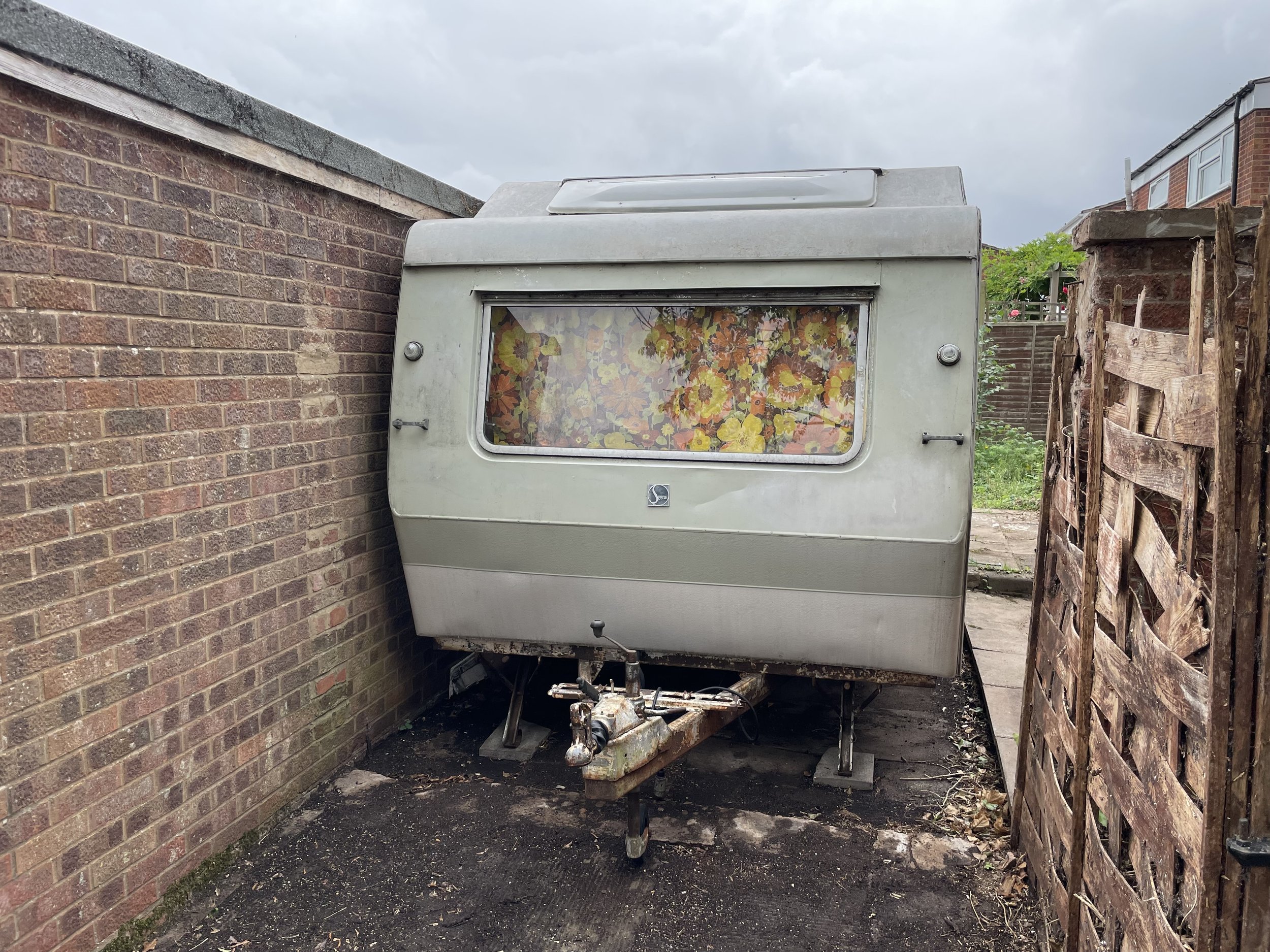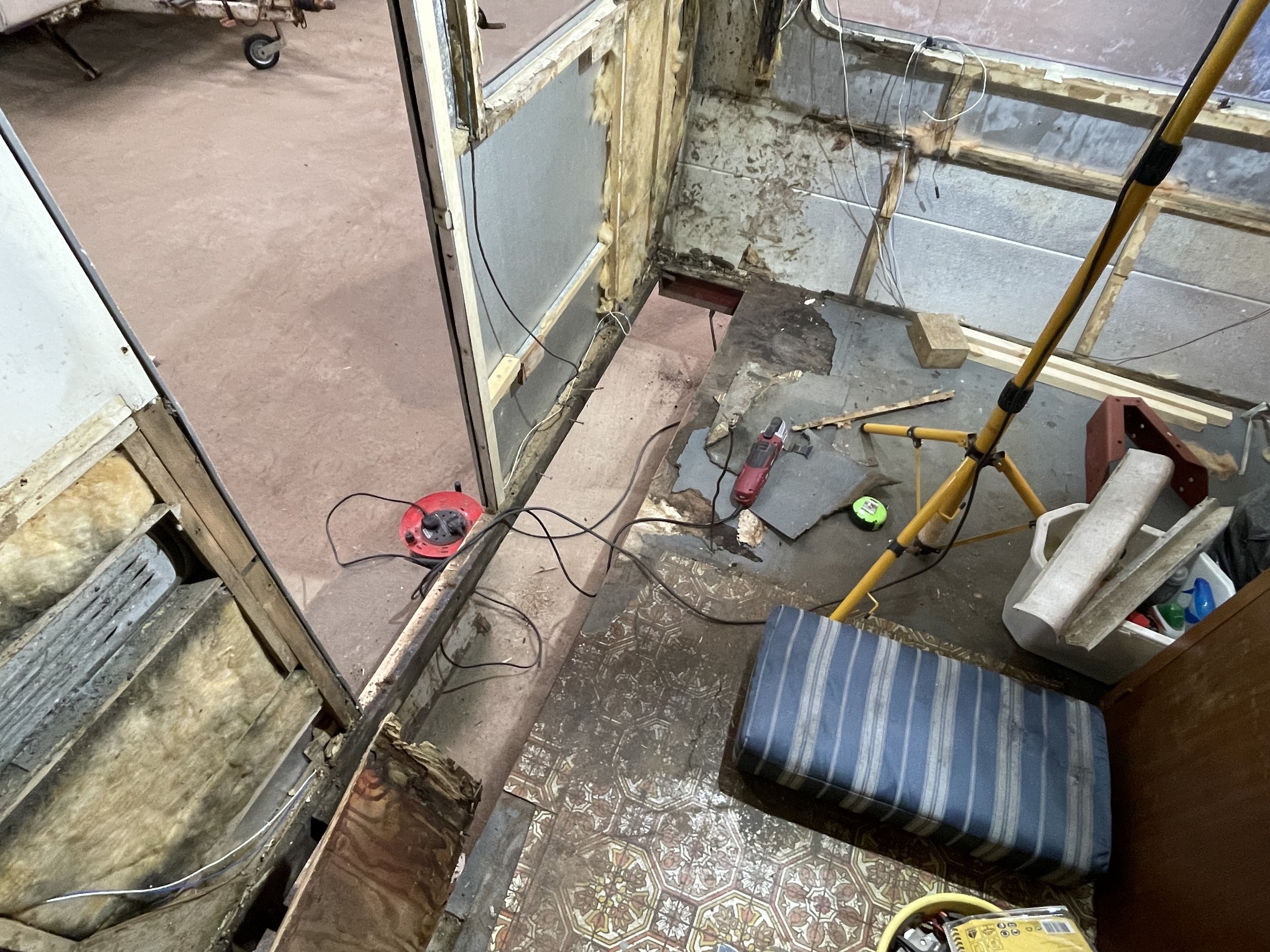1969
Sprite Major
The moon landing, Woodstock, Concorde’s first flight were all happening in 1969 when my Rover P6 was built. I wanted to find a caravan to go with it, and what could be better and more iconic than a 1969 Sprite Major?
In the early 1960s, the large 17ft 9in long Sprite Countryman was a poor seller. The reality was that “large” caravans like this were not widely used for touring holidays, with the average smaller engined cars of the day proving not powerful enough to tow them on the whole. So most of these large caravans were always destined for site use. Sam Alper, founder of Sprite, tried to encourage more people to tow these larger caravans by entering himself into the British Caravan Road Rally in 1961 with a Countryman and a Standard Vanguard, but he didn’t finish well because, you guessed it, the cumbersome size of the Countryman hindered the performance of the outfit in the challenges.
In the early 1960s, large caravans were not widely towed on the road.
The Countryman limped on into 1966, and Sam Alper decided to retire the model and announced to his dealership network that there would be no large Sprite model to replace it. Dismayed, they encouraged him to design something to replace it, but it should appear smaller than its size and be as family-friendly as possible to encourage more buyers. The Sprite Major was born.
Launched in October 1966, the new Sprite Major was still something of a beast compared to most caravans, but you couldn’t deny its beauty and it was certainly a head turner. Not one to rest on his laurels, Sam Alper arranged for a highly publicised PR stunt to tow the new Major around the Monza test circuit in Italy for 24 hours straight behind a Ford Zephyr V6. Despite some truly awful weather conditions, the outfit managed to average 70.2mph for the full 24 hours, which was really impressive considering that the towing speed limit in Britain at the time was just 40mph.
On the test circuit in Italy, the Sprite Major proved its towability, despite its size.
The stunt paid off, and the Major began to be a fairly frequent sight on campsites all over Britain and Europe soon after. The layout too was new - a twin dinette at each end of the caravan with a central washroom and kitchen. By the 1990s, this would be one of the best-selling layouts in the British caravan industry, but it was pioneered by the Sprite Major.
The Major experienced a huge facelift in 1968, altering the exterior coachlines and giving the front and rear panels a more curvaceous shape. The interiors too were improved, offering an extra layout in 1969 called the Major LB, with 6ft long bunks at the rear, while continuing to produce the original layout, now called the Major LK, with a 6ft long kitchen and 4ft rear bunks.
By 1969, the Major had been improved further and was selling really well.
Over in a London suburb, someone bought a brand new 1969 Major LB and enjoyed using it for family holidays for the next few years. In 1974, they sold it to a nearby family who were moving to a sleepy village in Worcestershire. They managed one trip out in the Major in 1974, where an incident occurred where the Major was mated with a fence post and required an insurance repair. The owner refused to tow the caravan again, and his son had the task of towing the Major from London to their new home in Worcestershire, where the wheels would not turn for the next 47 years!
Sales were good enough in 1969 to add a new layout to the range.
With an estate needing to be cleared, the son of the owners reached out to me to see if I would be interested in taking the Major on. The tale of the caravan, complete with its original 1969 crossply tyres still fitted, was very luring. Not to mention Sprite Majors are very rare now.
He sent some photos through and I could see that although it hadn’t moved for almost half a century, water had still got in. It turned out that a hedge had covered the front of the caravan over the years, and the branches had grown into the skylight, forcing it open and allowing water to pour in. The damage wasn’t terminal, but pretty extensive.
The Sprite Major in its resting spot for 47 years.
I didn’t think it would be a case of hitching up the Major to the car and heading home, but what I wasn’t expecting was how close the Major would be to the garage wall. To make matters worse, when I raised the corner steadies, the original tyre was completely flat, leaving the Major’s offside awning rail touching the garage wall. After an hour or so of thinking, we found some long planks of wood to place under the flat tyre and planned to gently pull the caravan forward with the car until it cleared the garage enough to change the wheel to one of the new spares that I’d brought along.
It took another hour, but eventually it was free and even the neighbours came out to see it as they’d never actually seen what the caravan looked like!
After a fight, I eventually got it out. Here you can see where the bushes grew onto the caravan over the years.
Once out, it took me another hour or so to strip the wheel hubs down and generally get the caravan ready to tow. I fitted new wheels/tyres, re-packed the bearings, adjusted the brakes (amazingly even the handbrake still worked!), attached a trailer lightboard, taped up any loose trim and made sure that all the windows were properly latched.
It was a tense few miles at first, constantly stopping to make sure that it was all okay. One of the shock absorbers had rusted up, but this soon freed off after a couple of miles. With about ten miles under my belt, I began to relax, and the Major towed home beautifully.
You cannot deny that this is one of the coolest looking caravans ever.
Sadly, the interior was in very poor condition, but it was at least complete.
The strip-down soon started and owing to the noisy and rusty suspension, I decided to start by overhauling the hitch unit and the suspension. Luckily, you can get pretty much all of the parts still. The shocks/springs from the suspension are from an MGTF and I managed to get some NOS ones for £25 each. The spring plates are also available, from a Triumph TR4/6, so I replaced these too. A local bearing specialist still had the correct size bearings for the wheel hubs, using the part number that was etched on the originals.
I stripped down the chassis with an angle grinder with a sanding attachment, finishing off hard to reach areas with a wire brush on a drill. I then gave it a coat of red oxide primer before giving it two top coats of silver.
Luckily, all the suspension parts are still available to buy.
I turned my thoughts to the interior, which was a little daunting if I’m honest. The sheer size of the caravan seemed to make everything take longer, so I just took it in stages to strip everything down. I very carefully removed all the wallboards to keep them in one piece and use them as templates for the new wall panels. The originals are made from hardboard, so even if they’re rotten, you can dry them out and they’ll hold their shape.
It turned out that for the most part, the framework was pretty solid throughout. A design flaw in the original sidewall design meant that over the years, the nearside wall behind the kitchen had slowly bowed outwards and lost its rigidity. So I carefully glued the overlapping sections back together and put in several new vertical beams to bring it back into shape. It was quite laborious, but worked well in the end.
A design flaw in the framework allowed it to slowly curve outwards over the years, something that I was able to rectify.
At this point, the more I pulled apart, the worse it seemed to get. What I thought was a small hole in the floor turned out to be a large area of rotten wood which had spread to the frame for the entrance door. This then needed completely cutting out and re-making. The floor was easy enough, but the door frame took much longer to fix.











